Pasta frola is a quince tart from Argentina, although like many Argentine recipes, it has its roots in Italy. It's made with a simple shortcrust pastry dough enhanced with citrusy orange zest. Filled with a fruity, thick quince jam and topped with a simple lattice design, this is an easy tart that highlights the unique apple-pear flavor of quince.
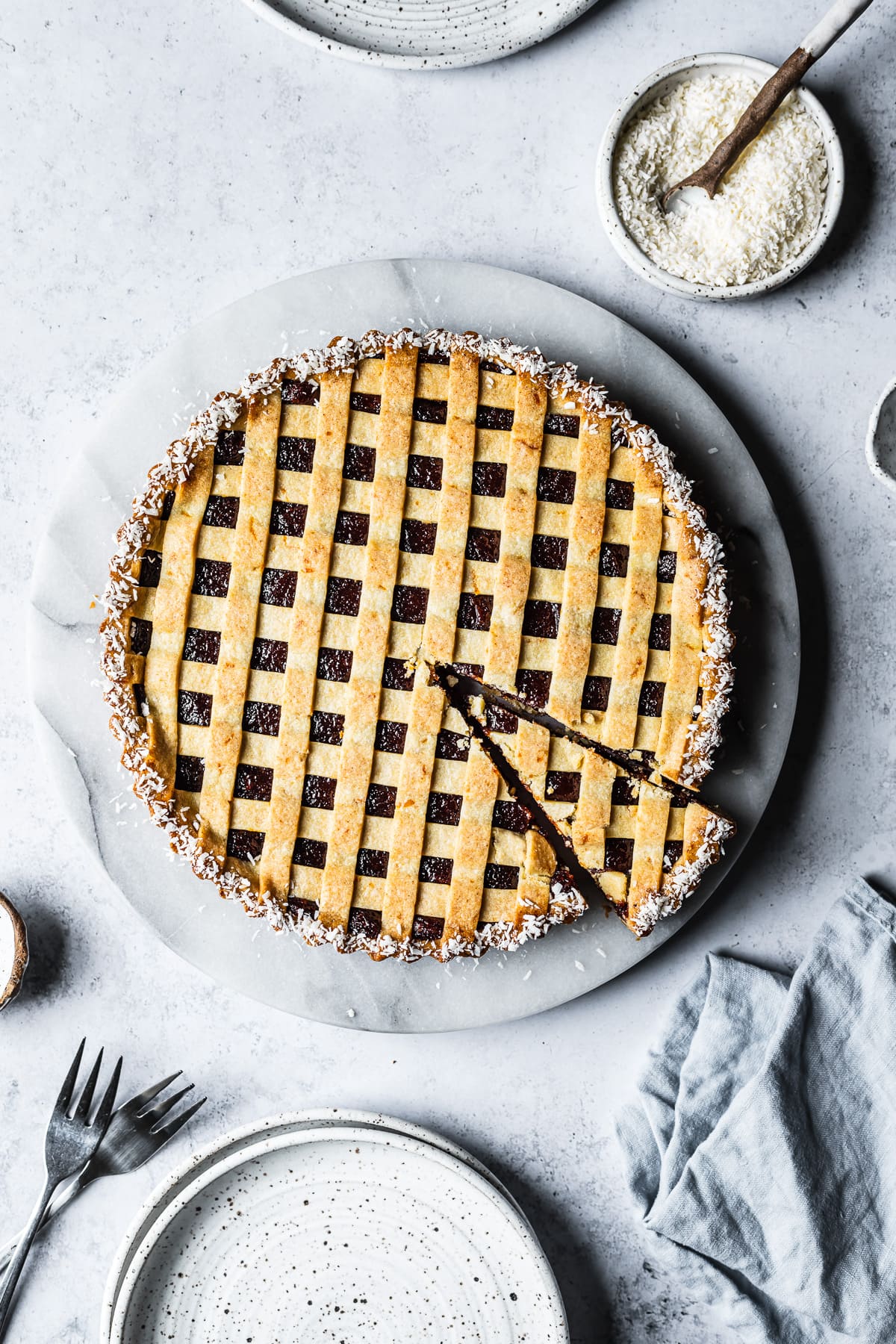
Pasta frola is a tart from Argentina that uses quince paste as its filling. Its origin can be traced back to Italy, where pasta frolla, shortcrust pastry dough, is a quintessential part of Italian baking. Pasta frolla is used in many Italian tart recipes, especially the classic crostata di marmellata.
You can find pasta frola in Argentina, Uruguay and Paraguay, among other South American countries. The base always consists of a buttery shortcrust pastry shell. The most common filling is quince paste (dulce de membrillo) but some recipes use guava paste, sweet potato paste, strawberry jam, or even dulce de leche.
The classic decoration for a pasta frola uses additional dough to form a simple lattice pattern on the top of the tart, in the same style as an Austrian Linzer torte (minus the ground nuts.)
This recipe for pasta frola came about when I was researching fillings for my recent Puerto Rican puff pastry recipe, quesitos. Concentrated fruit pastes such as guava paste and quince paste are common additions to the cream cheese filling, so I went down a bit of a rabbit hole learning about recipes using these dense fruit pastes.
Jump to:
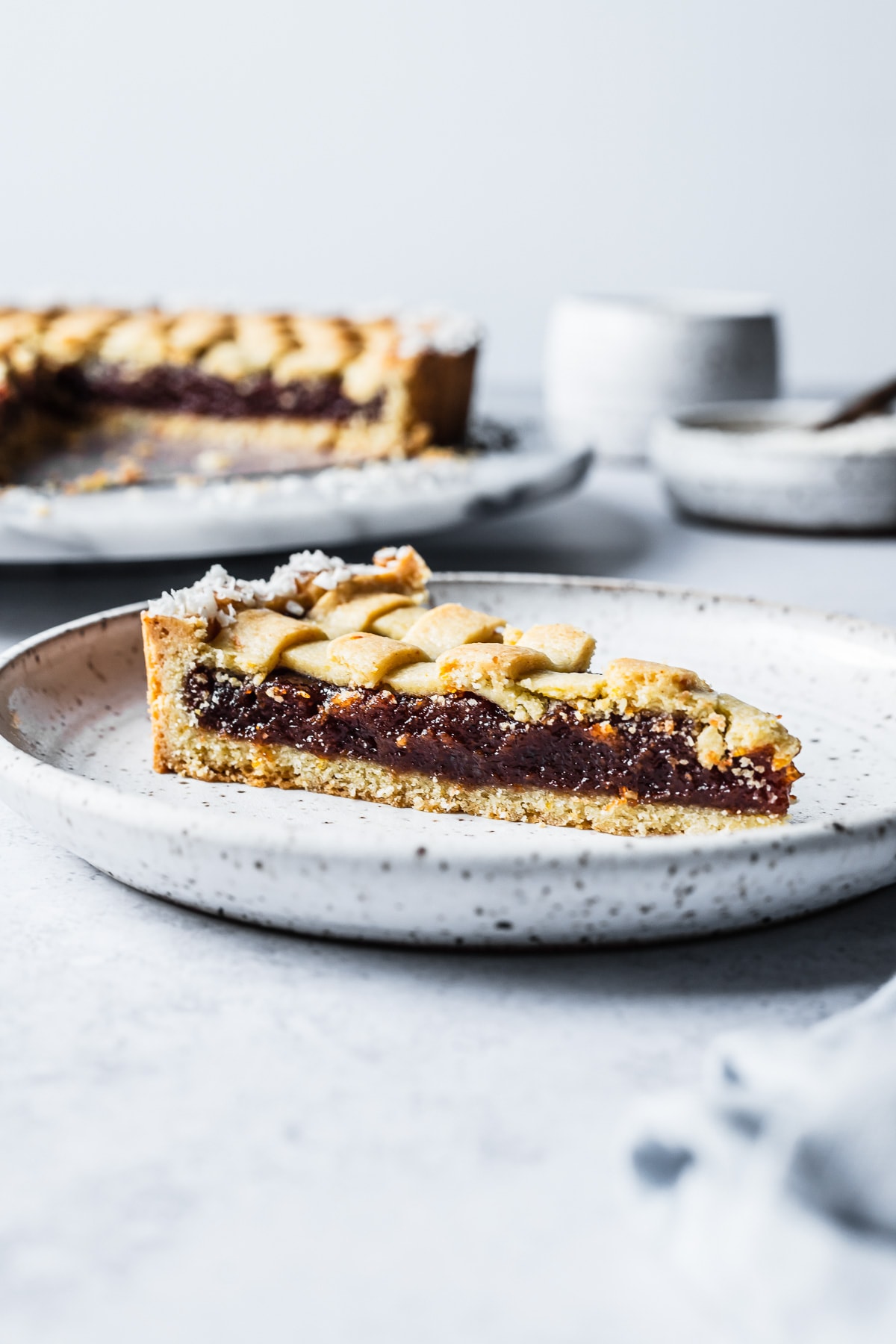
Ingredients
- Unsalted butter - Using unsalted butter allows you to control the total quantity of salt in the recipe. Salt content in salted butter varies from brand to brand.
- Orange zest - Finely grated orange zest provides a wonderful, bright citrus flavor and aroma. It smells so good when it's baking!
- Baking powder - Baking powder is a key ingredient in this pasta frola dough. It's added for leavening, giving the dough a softer, lighter texture than unleavened shortcrust pastry.
- Eggs - Your eggs should be at room temperature. For the egg yolk, I find it's easier to separate the yolk from the white when chilled, and then bring it to room temperature.
- Quince paste - You can often find quince paste in international grocery stores, or in the Hispanic section of supermarkets. You can also purchase it online. I bought two 250 gram (8.8 ounce) packages for a total of 500 grams. If your package is slightly smaller, feel free to use another jam to make up the difference if you prefer not to purchase extra quince paste.
- Orange juice - A bit of orange juice adds moisture and helps reconstitute the thick quince paste. You could also use water or an orange liqueur such as Cointreau or Grand Marnier.
- Orange marmalade - A small amount of marmalade brushed onto the tart border helps the coconut to stick. If you have another jam that would work, feel free to substitute. I used orange marmalade as I had it on hand and it complemented the other orange flavors in the tart.
- Finely shredded coconut - For decoration on the tart border. Use finely shredded, unsweetened coconut (affiliate link). If you can't locate finely shredded coconut, you can pulse larger flakes in a food processor or blender until fine.
See recipe card for full list of ingredients and quantities.
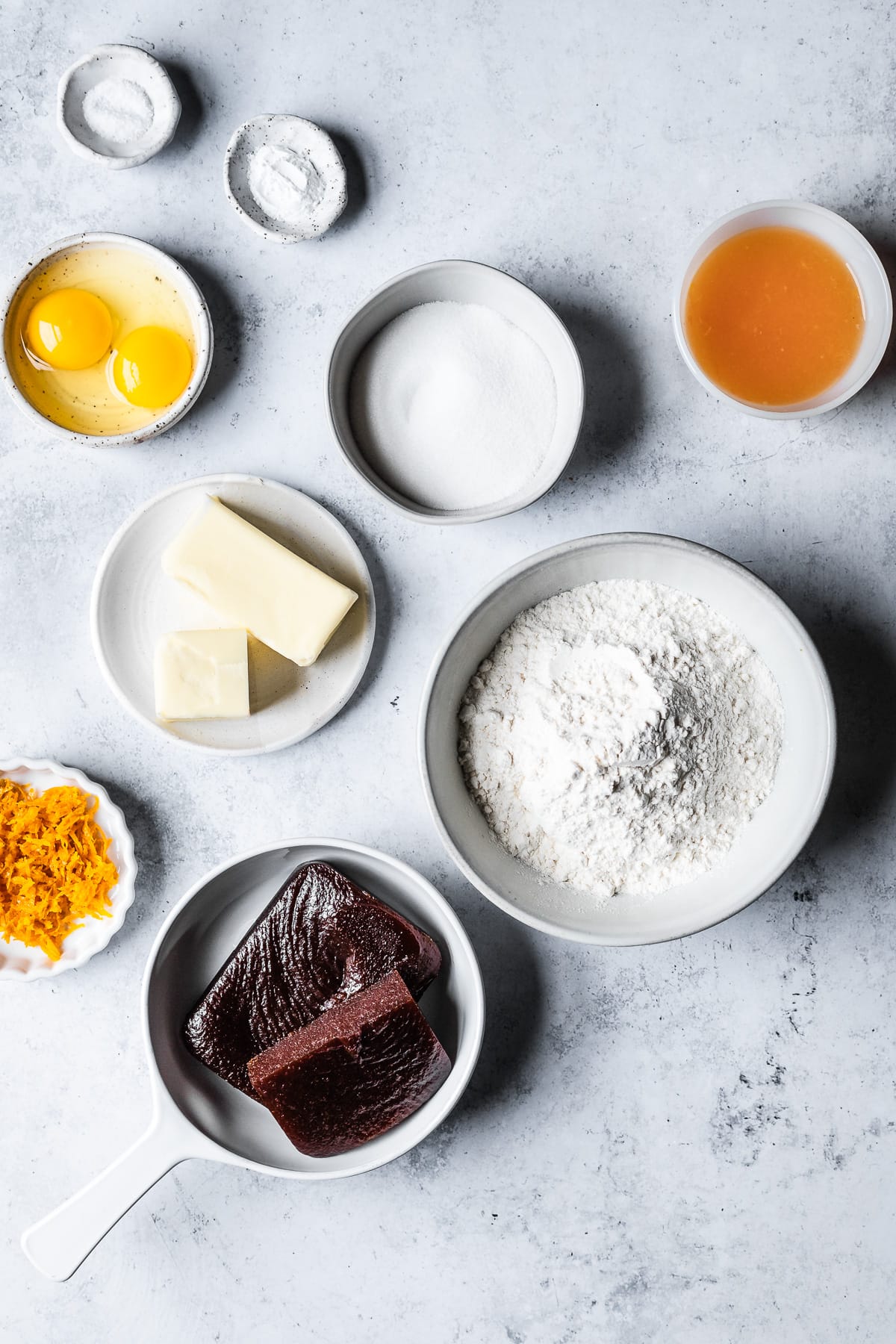
Instructions
Learn how to make pasta frola! Follow the photos and step by step instructions - it's quite easy.
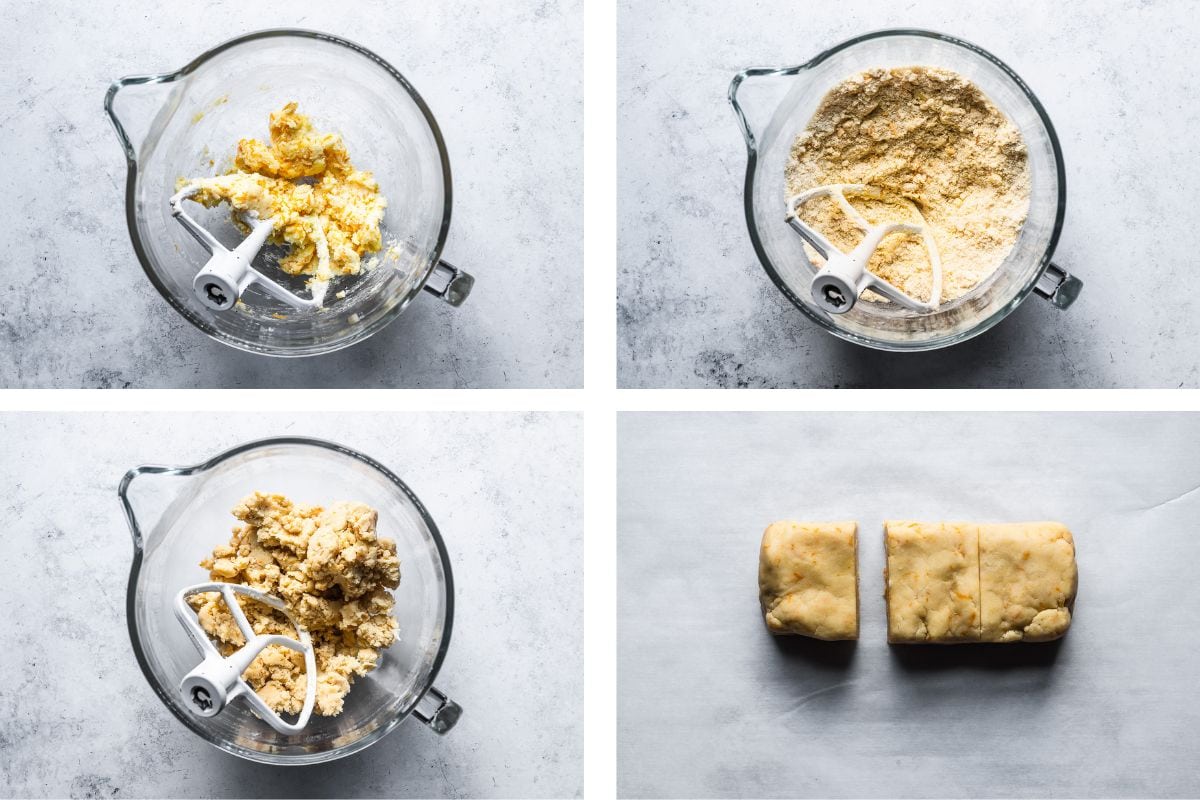
1: In the bowl of a stand mixer fitted with the paddle attachment, beat the butter and sugar on medium speed until well combined. Scrape down the sides of the bowl. Add orange zest and mix again.
2: Add flour, salt and baking powder. Mix on medium low speed until mixture resembles fine sand. Scrape down the bowl several times to ensure no large pieces of butter remain.
3: Add egg and egg yolk. Mix on low speed just until mixture comes together. Do not over mix.
4: Gather dough into a rectangle. Separate the dough into two uneven portions - one should be ⅔ of the dough, and the other should be ⅓. Flatten each dough piece into a round disc.
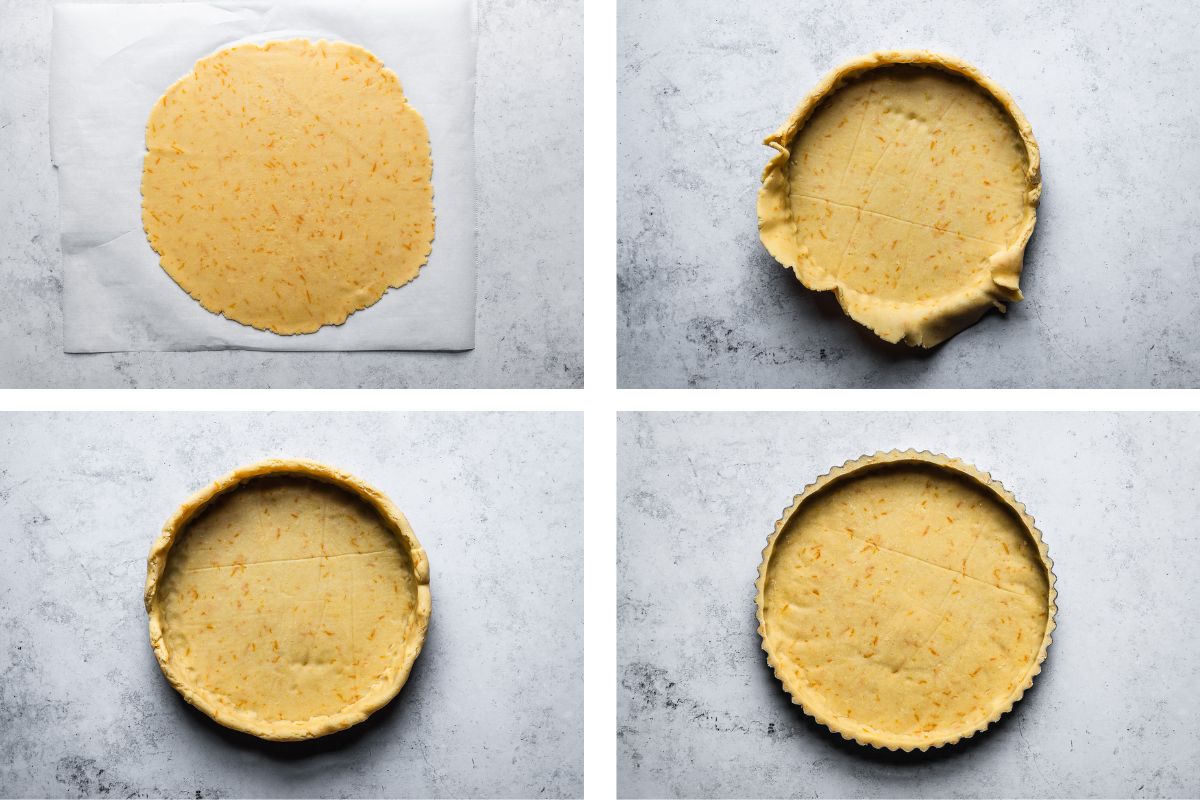
5: Roll out the larger piece of dough between two pieces of parchment paper (or a lightly floured surface, if you don't have parchment).
6: Carefully flip the dough upside down onto the top of the tart pan. Gently press the dough down into the pan while lifting up the overhang on the sides, ensuring that no empty air space remains between the dough and the pan.
7: I like to fold the overhanging dough in and down to meet the inside base of the tart, creating a somewhat thicker crust on the edge. Press dough firmly against the sides to ensure you pack dough in tightly. Place tart pan in refrigerator to chill for at least 30 minutes.
8: Trim the excess dough with a knife held parallel to your work surface to ensure the tart shell has a clean edge.
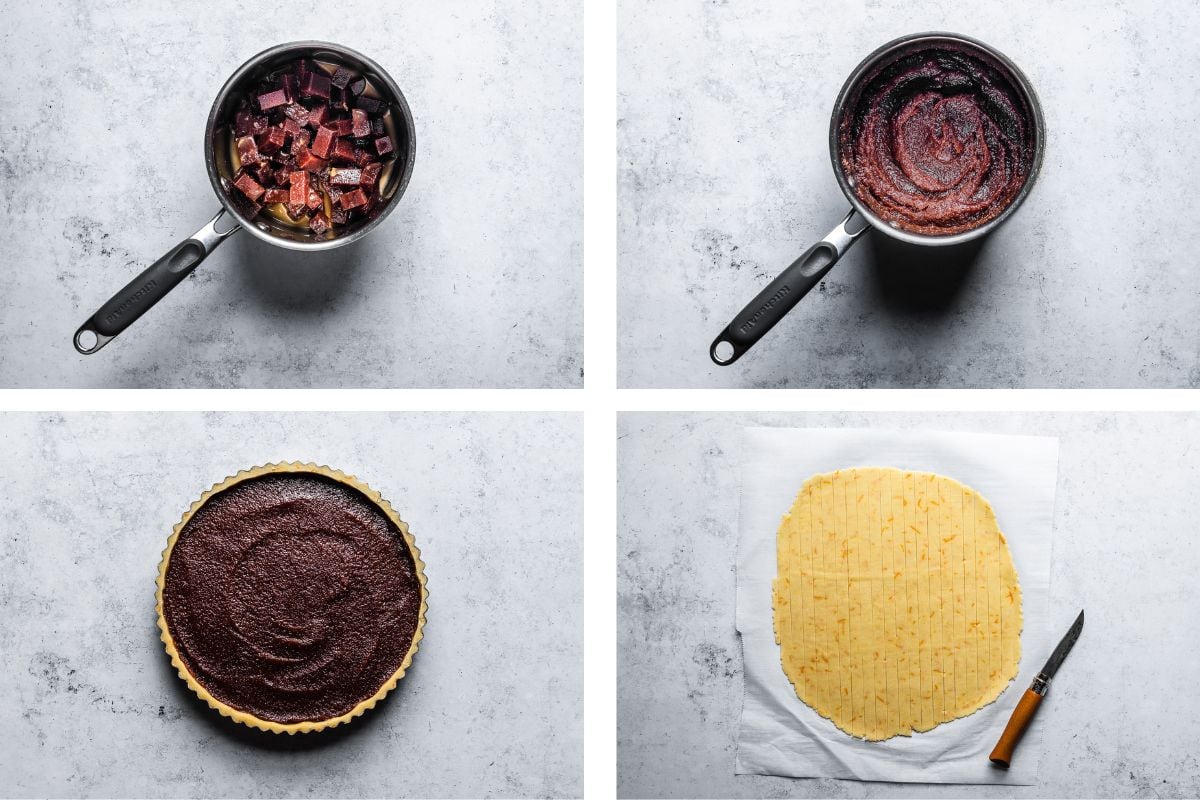
9: Chop the quince paste into small cubes. Place in a medium saucepan (2 quart, 1.9 liter) along with orange juice.
10: Stir over low heat until cubes fully dissolve and reach the consistency of smooth, thick jam. You may need to mash the cubes with the back of a spoon. Remove from heat and set aside to cool.
11: When the quince paste is cool, place it into the chilled tart crust and use a mini offset spatula or the back of a spoon to level and smooth the filling.
12: Roll out the second piece of dough between two sheets of parchment. Place on a sheet pan and chill in the refrigerator 30+ minutes.
13: Remove the smaller sheet of dough from the refrigerator. Loosen both layers of parchment paper, but keep the dough on a parchment base. Using a ruler and a sharp knife, cut the dough into long ½ inch wide strips. Place back on sheet pan into refrigerator to chill for a few minutes if dough is getting warm.
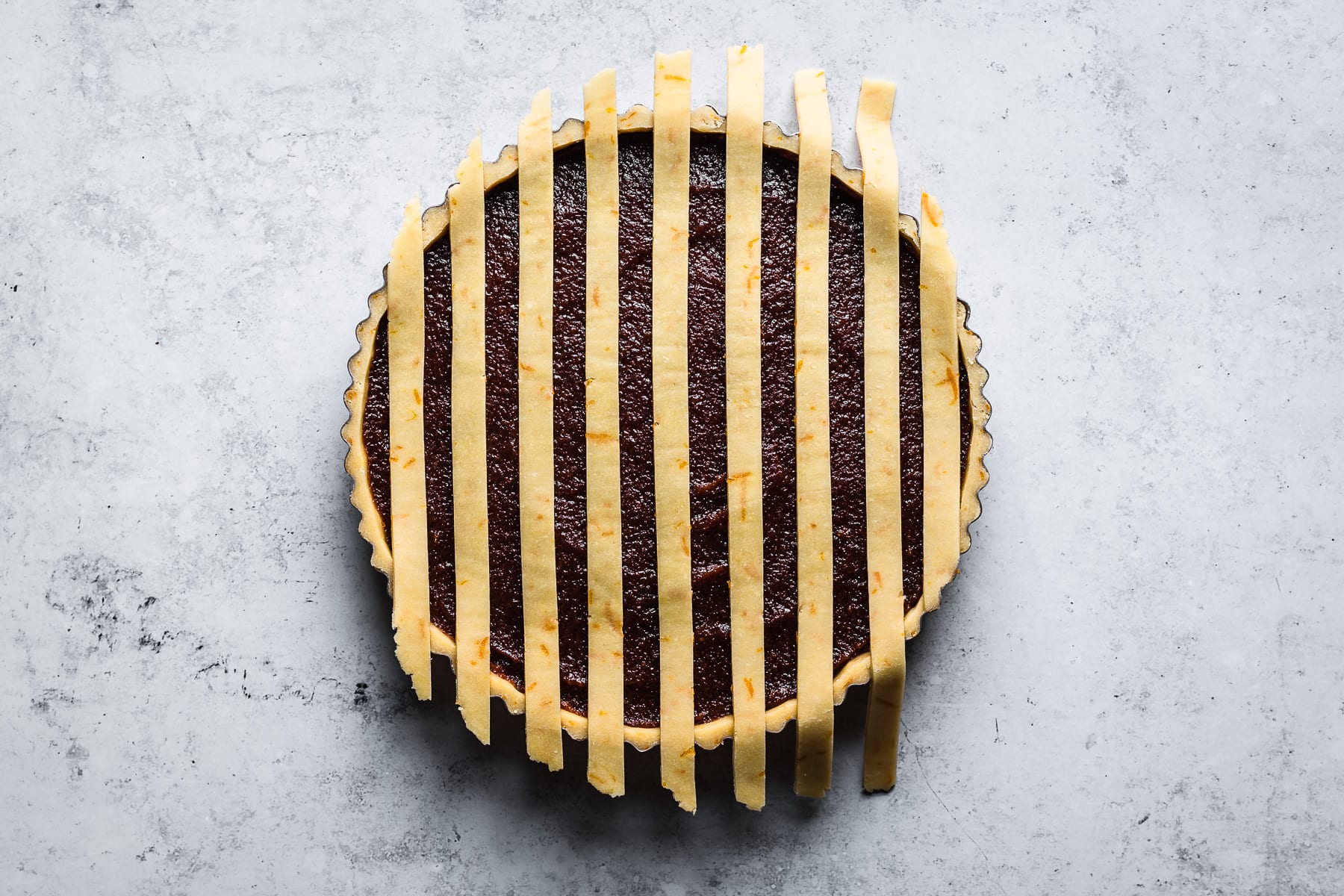
14: Place half of the lattice strips on the tart in one direction, spacing them about ½" apart. Press down gently on the edges to seal them. Trim the ends that overhang.
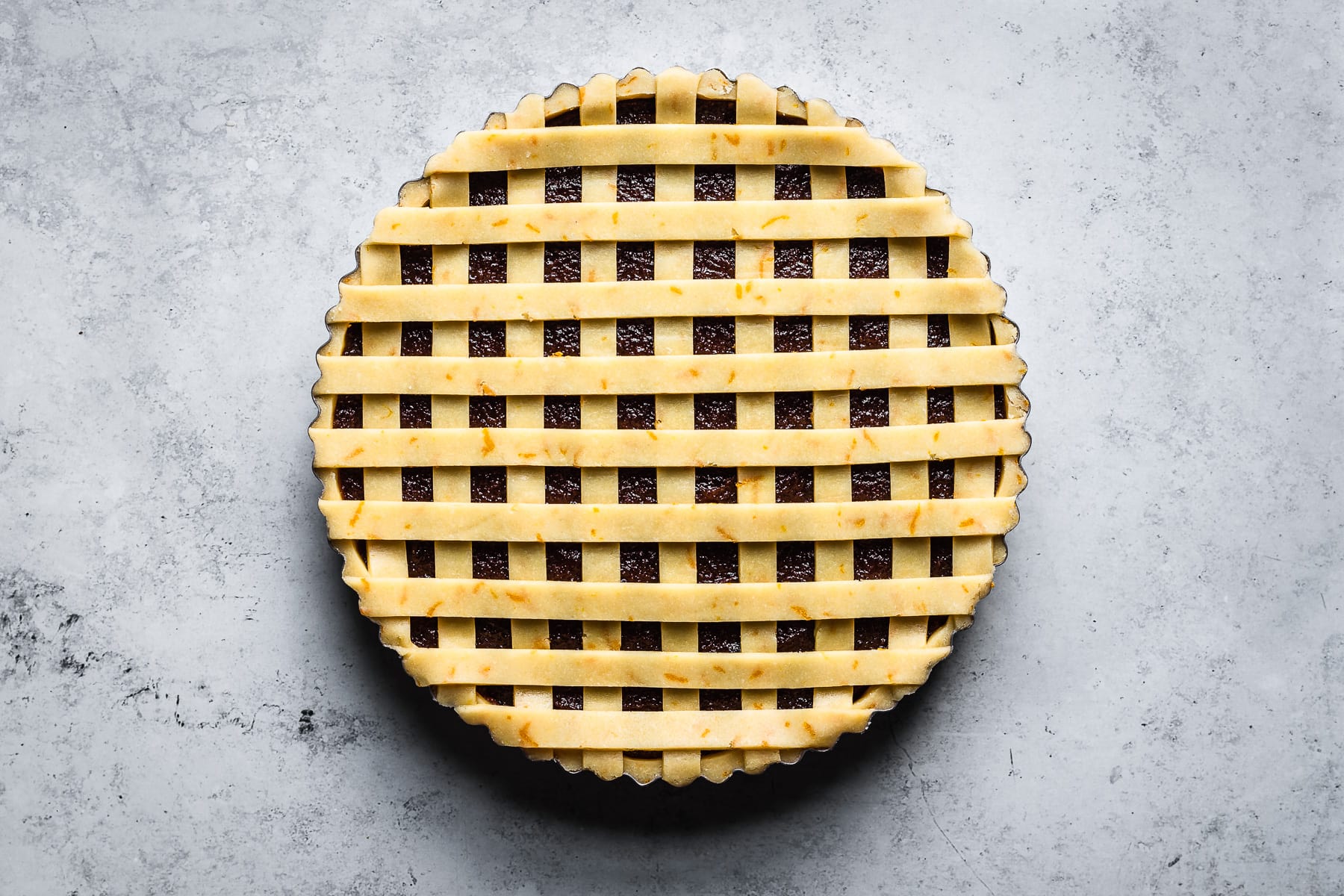
Turn the tart 90 degrees (one ¼ turn) and place the remaining half of the lattice strips perpendicular to the bottom layer. Trim the ends.
Place assembled tart in refrigerator to chill for 10 minutes.
Bake for 40-45 minutes, until crust is golden brown all over.
Hint: When baking the tart, check the crust after about 30 minutes. If it is already golden brown around the edges, cover it with a pie shield or cover the edges with strips of aluminum foil to prevent the edge of the crust from getting too dark.
Variations
If you'd like to try a variation on this quince paste tart, consider one of these options!
- Jam - Replace the quince paste with a different jam. The blackberry basil jam from my blackberry poppy seed cake would be a great option and makes just the right amount. Strawberry, raspberry, or a thick guava jam would also be delicious. For another tropical flavor, try this easy pineapple jam.
- Dulce de Leche - In Argentina, dulce de leche is another filling for pasta frola. Purchase a 14 ounce can from the store, or make your own easy homemade dulce de leche with my recipe. One can should be enough to fill this tart.
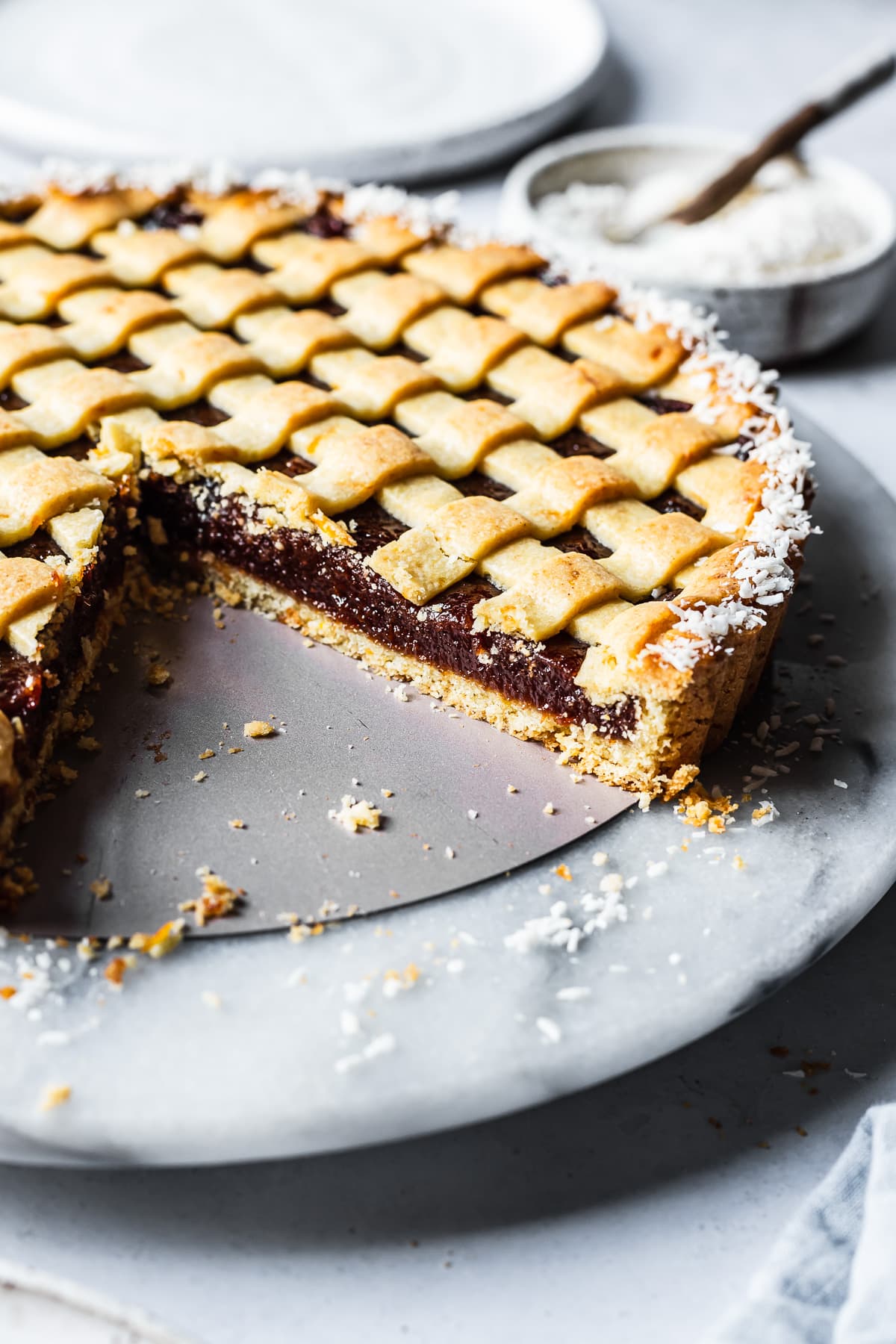
Equipment
Tart pan - For my tart recipes, I use this 9.5 inch nonstick carbon steel tart pan with a removable base.
Pie shield - I use a pie shield to protect the outer crust from browning too soon. I ended up adding the pie shield at the 30 minute mark while baking this pasta frola.
Pastry cutter - I generally use a ruler and a sharp knife to cut my lattice strips. Some bakers swear by a multi-wheeled pastry cutter. It's on my wish list! If you make many lattice pies and tarts, this will really save you time.
Storage
Store - Keep the tart in an airtight container at room temperature for up to 3 days.
Freeze - To freeze, wrap leftovers well and place in an airtight container or freezer bag for up to 3 months.
Recipe Tips
The quince filling should be cool (room temperature) before placing it into the unbaked tart shell. This will ensure the butter in the dough remains cool and firm prior to baking.
When working with dough for lattice, make sure you chill the dough well first. Cut the lattice strips after you chill the rolled out dough, and then place back into the refrigerator again until cool.
If the lattice strips become too pliable as you're placing them on the tart, pop them back in the fridge again for a few minutes.
Chill the fully assembled tart for at least 10 minutes before baking to ensure the butter in the dough is not too warm.
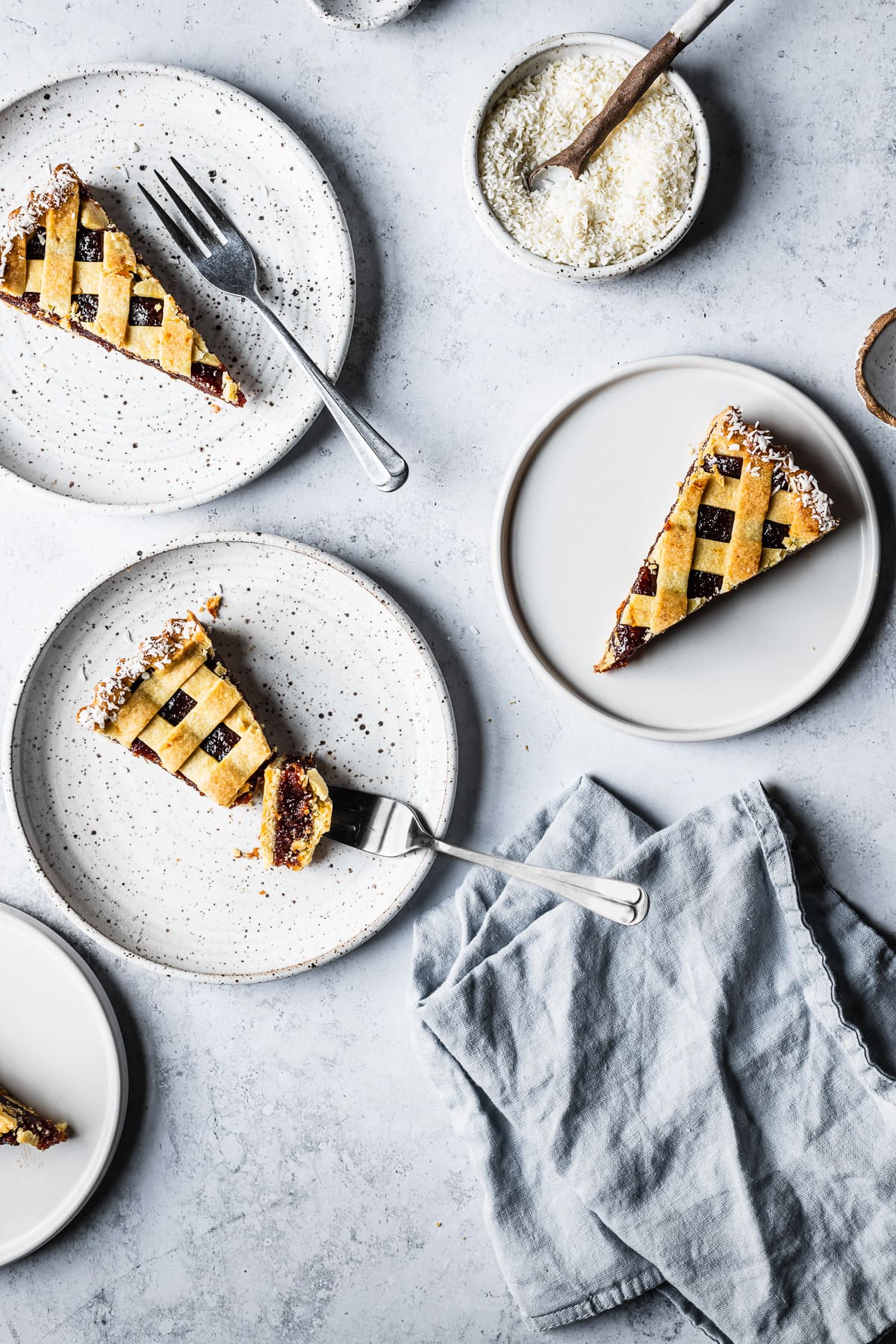
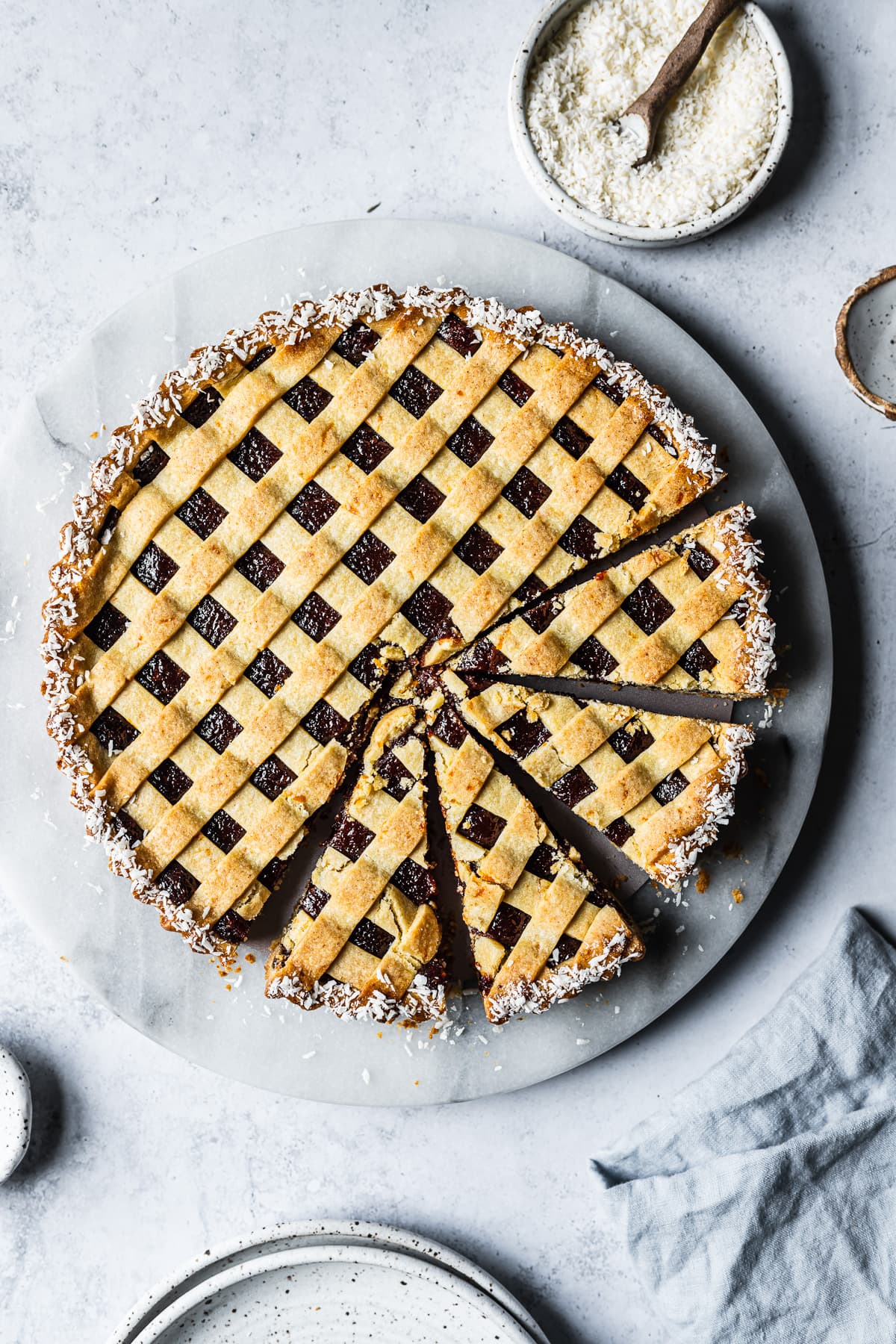
Frequently asked questions
Quince is the fruit of a deciduous tree. It looks similar in shape to a pear, but is more rustic looking, lumpier and much firmer. Its color is similar to a Golden Delicious apple.
When ripe, quince are hard and bitter, but become sweet and tender when cooked. Cooking also transforms the flesh from white to a striking reddish pink, activating the anthocyanin compounds which are also found in dark fruits such as blood oranges, raspberries and cranberries.
Quince are most frequently made into marmalade, jams and jellies, or reduced into the thick paste - known in Spanish as dulce de membrillo - that is used here. My friend Bella has some great recipes using fresh quince from her local trees.
What does a quince taste like? The flavor of cooked quince is often compared to something between an apple and a pear. Others describe its scent as guava-like, coconut, or even musk or violet. It's a unique fruit that you really must try!
Tarts made with jam are a traditional dessert in many countries. The Pasta frola tart is Argentine, but originates in Italy where the shortcrust pastry dough is called pasta frolla (note the second L.)
In Greece, the letters were transposed at some point and Greek jam tarts are known as pasta flora.
Love this recipe? Please leave a comment and star rating. ★★★★★ Your feedback, suggestions, and adaptations are very helpful to other bakers!
📖 Recipe
Pasta Frola (Quince Tart)
INGREDIENTS
Pasta Frola Dough
- 170 grams (6 ounces, 12 Tablespoons) unsalted butter, (room temperature)
- 100 grams (½ cup) granulated sugar
- zest of 1 orange
- 300 grams (2½ cups) all purpose flour
- 2 grams (½ teaspoon) Kosher salt
- 1 teaspoon baking powder
- 1 large egg
- 1 large egg yolk
Quince Paste Filling
- 500 grams (16.6 ounces; 2 cups) quince paste
- 4 Tablespoons (¼ cup) orange juice
Decoration
- 20 grams (1 Tablespoon) orange marmalade (or another jam/honey)
- 15 grams (3 Tablespoons) unsweetened shredded coconut
INSTRUCTIONS
Pasta Frola Dough
- In the bowl of a stand mixer fitted with the paddle attachment, beat the butter and sugar on medium speed until well combined. Scrape down the sides of the bowl. Add orange zest and mix again.170 grams (6 ounces, 12 Tablespoons) unsalted butter, 100 grams (½ cup) granulated sugar, zest of 1 orange
- Add flour, salt and baking powder. Mix on medium low speed until mixture resembles fine sand. Scrape down the bowl several times to ensure no large pieces of butter remain.300 grams (2½ cups) all purpose flour, 2 grams (½ teaspoon) Kosher salt, 1 teaspoon baking powder
- Add egg and egg yolk. Mix on low speed just until mixture comes together. Do not over mix.1 large egg, 1 large egg yolk
- Gather dough into a rectangle. Separate the dough into two uneven portions - one should be ⅔ of the dough, and the other should be ⅓. Flatten each dough piece into a round disc.
- Roll out the larger piece of dough between two pieces of parchment paper (or a lightly floured surface, if you don't have parchment). It should be about ⅛" thick and the circle should be an inch wider than your tart pan on each side. Peel the parchment off of the top, and then replace. Flip the dough over while still sandwiched between parchment layers. Peel off the second parchment layer and discard.
- Carefully flip the dough upside down onto the top of the tart pan. Gently press the dough down into the pan while lifting up the overhang on the sides, ensuring that no empty air space remains between the dough and the pan. If any cracks or tears occur, patch with extra dough scraps. I like to fold the overhanging dough in and down to meet the inside base of the tart, creating a somewhat thicker crust on the edge. Press firmly to ensure dough is packed in tightly. Place in refrigerator to chill for at least 30 minutes. You will trim the overhang later.
- Meanwhile, roll out the second piece of dough between two sheets of parchment. Place on a sheet pan and chill in the refrigerator as well. While the dough is chilling, make the quince paste filling.
Quince Paste Filling
- Chop the quince paste into small cubes. Place in a medium saucepan (2 quart, 1.9 liter) along with orange juice. Stir over low heat until cubes fully dissolve and reach the consistency of smooth, thick jam. You may need to mash the cubes with the back of a spoon. Remove from heat and set aside to cool.500 grams (16.6 ounces; 2 cups) quince paste, 4 Tablespoons (¼ cup) orange juice
Tart Assembly
- Place a sheet pan in the oven on the middle rack. Preheat oven to 350 degrees Fahrenheit (177 Celsius, Gas mark 4).
- Trim the excess dough from the border of the tart with a knife held parallel to your work surface to ensure the the tart shell has a clean edge. Place back in refrigerator to chill.
- Remove the smaller sheet of dough from the refrigerator. Loosen both layers of parchment paper, but keep the dough on a parchment base. Using a ruler and a sharp knife, cut the dough into long ½ inch wide strips. Place back on sheet pan into refrigerator to chill.
- When the quince paste is cool, place it into the chilled tart crust and use a mini offset spatula or the back of a spoon to level and smooth the filling. Place half of the lattice strips on the tart in one direction, spacing them about ½" apart. Press down gently on the edges to seal them. Use a knife to trim the ends that overhang. Turn the tart 90 degrees (one ¼ turn) and place the remaining half of the lattice strips perpendicular to the bottom layer. Trim the ends.
- Place tart in refrigerator to chill for 10 minutes.
- Bake for 40-45 minutes, until crust is golden brown. Check the crust at 30 minutes. If outside edge of crust is already turning golden, cover with a pie shield or strips of aluminum foil.
- Place on a baking rack to cool. Once somewhat cooler, use a pastry brush to brush the outer crust with orange marmalade. Sprinkle with finely shredded coconut.20 grams (1 Tablespoon) orange marmalade (or another jam/honey), 15 grams (3 Tablespoons) unsweetened shredded coconut
- Wait until tart is cool to slice. (Or break the rules, live on the edge and serve it warm).

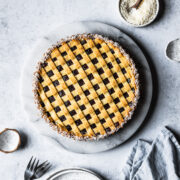

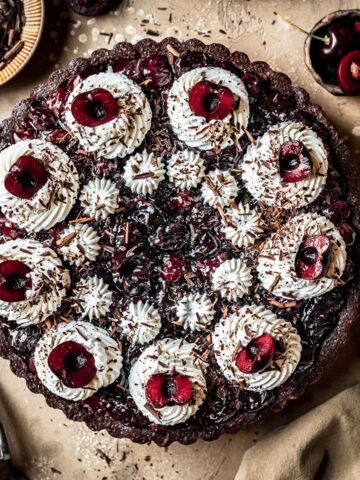

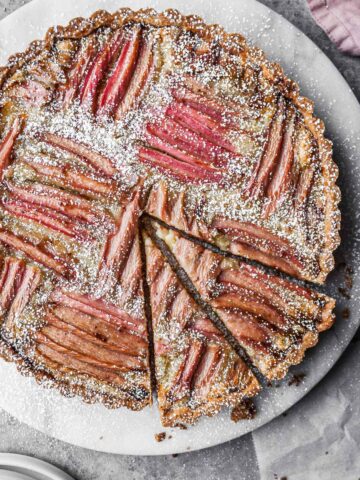
Debra S. Kingsley says
This is a fabulous recipe. My husband is from Argentina and I have had this many times but was always intimidated to make it. I followed the directions exactly with a major change. Since I am gluten free I used GF Jules gluten free flour for the crust. I needed to add a little water to the dough because the gluten free dough tends to be dry. It came out flaky and the filling delicious! Will be making this for years!
Kathleen Culver says
Hi Debra,
Thanks so much for your comment, and for the feedback regarding the gluten free flour.
I'm so glad that you found a great GF replacement that worked for you!
My husband is from Spain, so I know just how nice it is to make special recipes from home.
Thanks for baking my recipe! Argentinian desserts are so good - I've also got recipes for alfajores and chocotorta you can check out!
Kathleen